Human Occupied Landfill by DivineCoffeeBinge
Introduction
Original SA post
With twice as many votes as any other book (okay, two votes versus the others' one apiece), it's time to take a brief break from Pendragon and bring you...
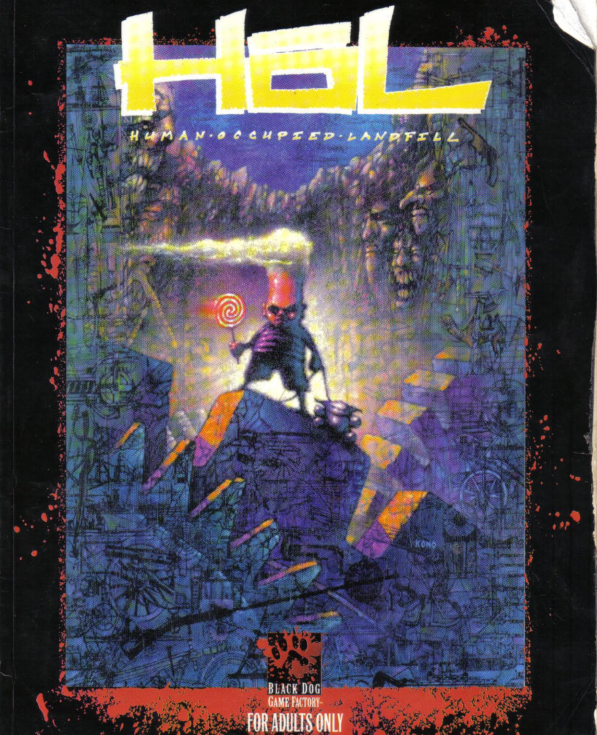
HoL: Human Occupied Landfill
by Daniel Thron, Todd Shaughnessy, and Chris Elliott, published by Black Dog Game Studios (yes, them).
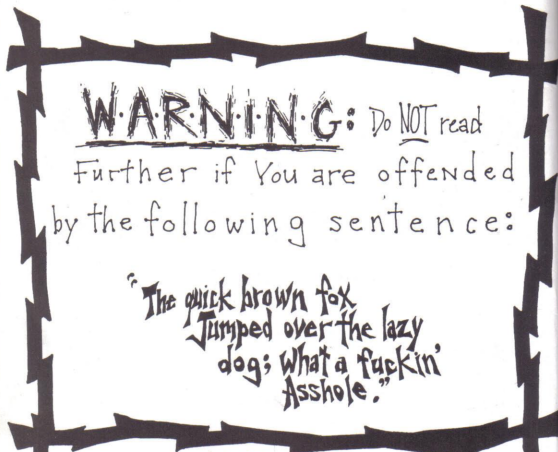
Yeah, that should tell you what kind of ride we're in for here, shouldn't it? HoL is not a game that takes itself seriously; it's a parody. Unlike a lot of parody games, though, it's actually pretty damn playable! It's also entirely handwritten, which isn't exactly easy on the eyes a lot of the time and is going to make excerpting for you a serious pain in the ass. I'll handle it, though. I'm tough. I'm a fuckin' trooper. Not just a Spider-Man, a
Hard Hat Spider-Man
, that's
significant
, yo. I've got a shitload of caffeine and I'm not afraid to use it, motherfuckers.
(you may notice a distinct uptick in my vulgarity level. What can I say? it fits the mood)
HoL's introduction starts by asking us, "What is Roleplaying?" and getting about two lines into Standard Artsy-Game Roleplaying Discussion before writing
FUCK THIS NOISE!!!
in inch-tall letters. "This isn't going to be your first game," the book tells us. "If it is, you fucked up. Go play (you know the one - it sounds like 'Truncheons & Flagons but we can't say it 'cause of copyright laws) for about six years, then get back to me."
This book, the intro goes on to explain, is divided into two sections, the Player's Section and the Gamemaster's Section. Only those names suck, so instead they've been renamed to "Killing Things" and "Things That Can Kill You." Also, HoL GMs are called Holmeisters. Oh, and if you're a player, don't read the second half, or you'll find out that the HM can cheat. Like, whenever he wants. Then there's a paragraph about how awesome HMs are, because - as they admit in a footnote - HMs are the guys most likely to buy supplements.
....yeah. This should be interesting.
Where the Fuck Are We?
Original SA post
You know what, screw it. Let's do another bit and we'll see if I can do the book justice or if I just look stupid defending something ridiculous. Or both, that can happen too, screw it.
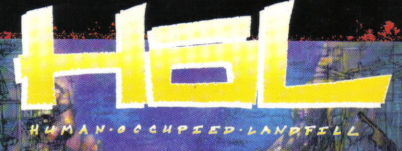
So let's see what the book leads off with...
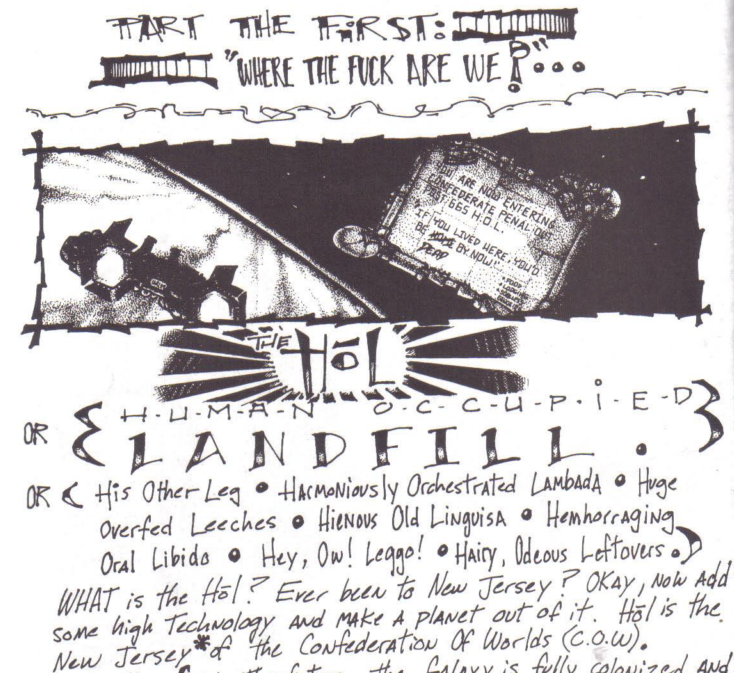
HoL exists on the ass-end of the universe. It is, in short, the galaxy's garbage dump. The Confederacy Of Worlds (or 'COW') designated HoL to be the universal garbage dump... and then realized that aside from being a great place to deposit mounds of broken toasters and discarded blow-up dolls, it would also be a great place to deposit the worst murderous sociopaths the galaxy has to offer. Also, large numbers of excess accountants. Typically you will not be playing accountants.
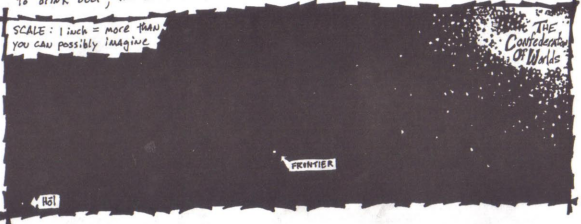
Galactic formation does not work that way
Now, there are two major organizations that run basically the whole cosmos. One is the aforementioned COW, which is basically the WH40K Imperium of Man played for laughs. The other is The Church, run by His Holiness Rashneesh "Big Stevie" Zimmerman, the Megapope. The Church is basically every conspiracy theorist's notion of the Catholic Church, only merged with the galaxy's biggest fast food chains to create the galaxy's most beloved institution, Church & Munch.
This is just the teaser section, though, so the details (such as they are) come later. First we get...
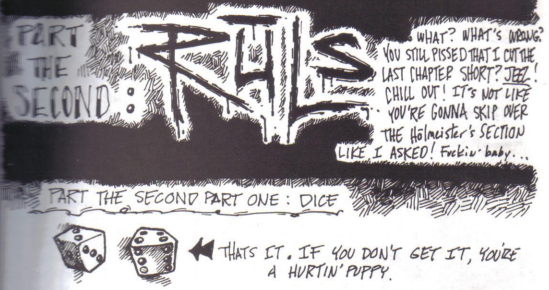
Everything in HoL uses 2d6, aiming for a target number. If you roll boxcars you're awesome, and can roll again and add the two rolls. If you roll snake eyes, You Lose. Sucks to be you. In the book's words, "with this mystically pitiful roll, you grant the Holmeister unlimited retaliatory power against you for anything you may have done (or thought of doing) to him or her during your life."
There's a few charts. To sum up the gist of it, you take a Stat plus a Skill plus your roll plus/minus any modifiers and compare that to the chart. 15 or more is a success. The better you succeed, you get bonuses to your relevant Stat for 1d6 turns (+1 for 20+, +3 for 25+).
That's fuckin' it.
Modifiers can be whatever the HM decides to assign; examples range from +4 to the roll for "easier than a cheap streetwalker" to -4 to the roll for "Bogusly Difficult." Players can beg the HM for lower penalties. The game does not condone the use of sexual favors in said begging.
EXAMPLE TIME
quote:
Ed, staring dejectedly at his malfunctioning EX-109 CraterMaker Assault Cannon and Soup Thermos, decides to attempt a patch job using his Repair Toasters and Stuff skill. The HM arbitrarily states that the task is Bogusly Difficult, giving a -4 penalty to Ed's roll. Ed throws the dice and gets a 5 and a 6, totaling 11 (no shit). His Greymatta stat is 4, and his skill is 2, so taking the -4 modifier into account Ed consults the chart and proclaims his attempt a success, because 11+4+2-4=25 (or 13 if you're not cheating).
Yes, 13 does not actually succeed. Proofreading! Anyways, it's a simple, easy system, which is important for an intended beer-and-pretzel game like HoL, but it holds up fairly well under actual play conditions. It's not exactly an easy system to fuck up, after all.
There's then another pair of charts for rolling a random 'You Lose!' result; rolling snake eyes on this chart (which you only rolled on because you rolled a snake eyes) is bad for you don't do it.
NEXT TIME ON HOL: COMBAT! YES! FUCKING FINALLY!
Combat: We Can Finally Kill Things
Original SA post
So what were we talking about? Oh, right -
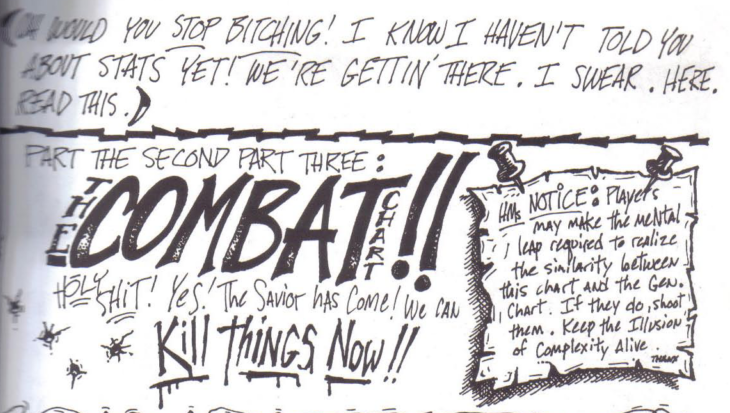
There's a Combat Chart, which is exactly the same as the regular Chart only it's about combat. High levels of success do not add to skills or stats; they add to your weapon's "Anguish Factor."
Conveniently enough, the next page gives us a list of "Anguish Factor Equivalencies," ranging from 1 (stapling your finger) to 8 (crushing your ankles with a sledgehammer) to 20 (unprotected reentry into the atmosphere).
More charts - first, the Damage Multiplier Chart. Take your weapon's Anguish Factor and subtract your target's Armor value, then roll 1d6 to find whether you get to multiply your weapon's damage by anything. This will all make sense in a minute when I explain what the fuck we're talking about. Finally, a list of Wound Modifiers, giving penalties to actions depending on how many wounds you've taken (5 wounds, "worse than a paper cut, less than a bone marrow transplant," -1 penalty; 13 wounds, "rather be shaving with a chainsaw," -3 penalty; 17 wounds, "appointment with death's receptionist," unconscious; 20 wounds, "the big dirtnap," dead).
Finally the game tells us about range modifiers and such, but then gets to the next part: Putting this all together (with some other stuff, too) so you can kill things.
Short form - weapons have an Anguish Factor and a Damage Rating, abbreviated A/D (for instance, the RX-109 CraterMaker Assault Cannon and Soup Thermos has an A/D of 16/4, making it fairly brutal; the Ek-Sacto Knife has an A/D of 15/1, while the Kindred Army Anti-Oppression Blaster has a pretty sad 6/2).
The higher the weapon's Anguish Factor, the more likely it is to have a positive multiplier to its damage; the Damage Rating is how much damage it actually does . The aforementioned Kindred Army Anti-Oppression Blaster theoretically does twice as much damage per attack as the Ek-Sacto Knife, but the latter's high Anguish Factor (those fuckers sting if someone takes a swipe at you with one) means it can often outperform the former.
Don't believe me? Example time! This is my example, not the book's combat example, which is a good deal funnier. The "Weekend Warrior Leisure Battlesuit" (available only in bright neon safety colors) has an Armor Rating of 6. Using the Kindred Army Anti-Oppression Blaster on someone wearing one gives you a roll on the 0 column of the Damage Multiplier Chart (6-6=0), which gives a result of "*0.5" on a roll of 1, to a "*1" on a 2-5; ergo, you do 2 damage at most, assuming you don't get unlucky and roll a 1.
Using the Ek-Sacto Knife, however, lets you roll on the 9 column, which gives a *2 on a 1-2 or a *3 on a 3-6; 66 percent of the time you're actually out-performing the dude with the laser blaster (but at least he can fire at range).
Wound levels, as you might have guessed, are pretty much standard. Everyone has 20 HP and gets penalized for losing them. Thing is, your character's Meat stat is factored in while taking damage - it counts as armor rating, so, um, pretend the dude in the above example has a Meat of 0 shut up - so low-Meat characters get hurt at a greater rate than high-Meat characters. Nothing new here, really.
Combat is not exactly tricky. Initiative is rolled, someone attacks, someone else either parries (if possible) or dodges, someone gets hit, someone takes damage, wash, rinse, repeat.
Special combat maneuvers are then explained: they are Aiming, Beaning (i.e. 'huck this thing at that guy's head and make him nap'), Begging ("pleasepleasepleasepleaseplease don't kill me"), Bolting ("run like fuck"), Crotch-Soccer (staple of playground fights everywhere), Goin' Psycho (berserker rage, dude), "LOOK!" (you know, the ol' "what's that behind you?!?" trick), Rag On (make fun of the bad guys until everyone at the table laughs), and "Wastem In The Face," a reference which makes no sense to you yet, sorry.
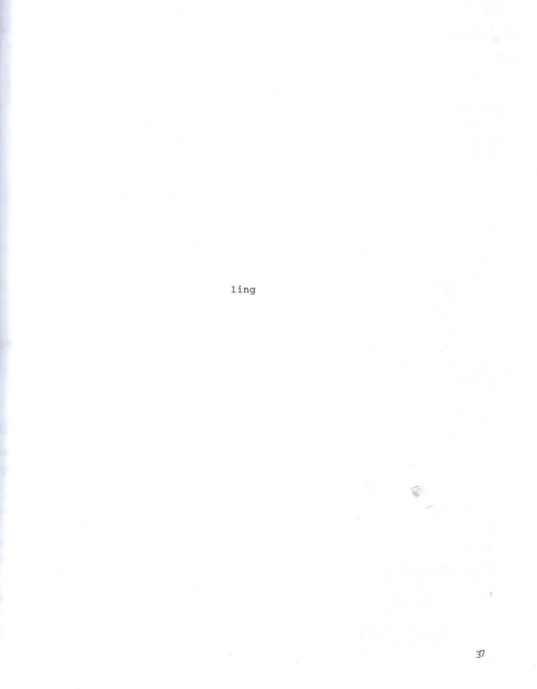
Page 37
Vehicle Combat is then discussed, except since vehicles don't have stats like people do they have their own stats, which are Hull Rating, Speedosity, Turnableness, and Bigness; then Bitchingly Huge Combat comes into play, which is basically like giant space battlecruisers and shit shooting at each other.
Bitchingly Huge vehicles don't have Hull Points, they have Mondo Hull Points, which are regular roughly equal to 1000 regular Hull Points and anyone who's played a Palladium-derived system should be getting sympathetic headaches right now.
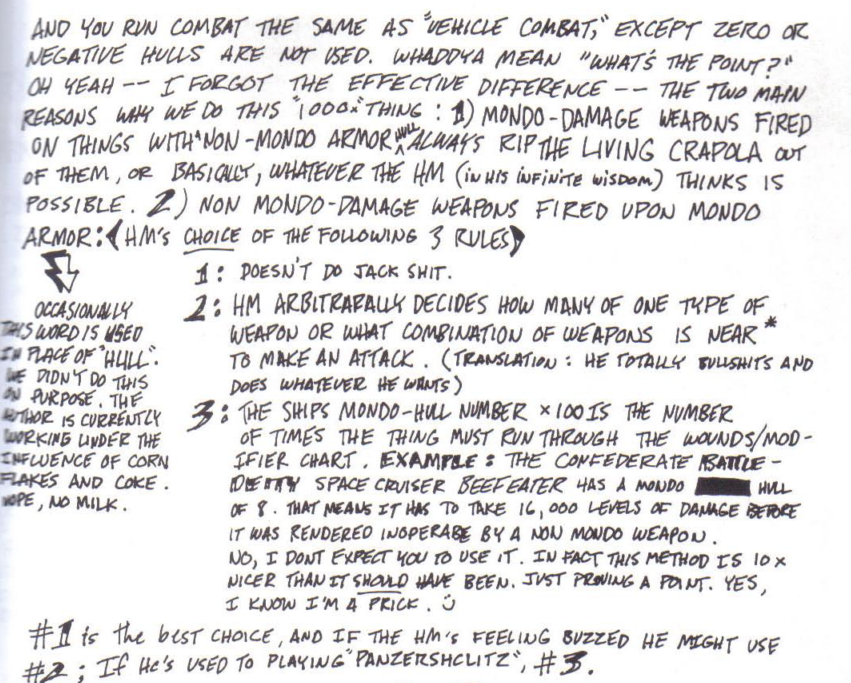
...yeah, that's enough to think about for the moment. Next section is on Characters, so that should be interesting...